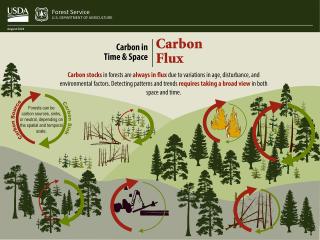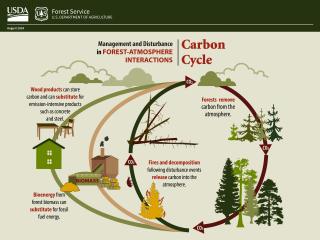Carbon
Effective beginning 5/20/2025
This website, and all linked websites under the control of the agency is under review and content may change.

Carbon is one of the basic building blocks of forest vegetation and soils. Trees and other vegetation absorb carbon dioxide (CO2) through the process of photosynthesis and store it in leaves, branches, roots, and trunks. When plant parts die and decompose, some of their carbon can be transferred to the soil, where some may remain for a long time. CO2 is the primary greenhouse gas released into the atmosphere through human activities that is contributing to rising global temperatures. Therefore, the uptake, storage, and stability of carbon in forests are all key components of climate change mitigation. Careful carbon stewardship can limit the adverse impacts of climate change on ecosystems and communities.
Efforts to monitor carbon in forests and grasslands produce the authoritative research, analyses, and tools used to estimate carbon stocks and track change over time across the nation. These estimates contribute to national reports, such as the National Greenhouse Gas Inventory for annual reporting under the United Nations Framework Convention on Climate Change; the forest sustainability report for the Montreal Process; and carbon assessments across national forests and grasslands.
Carbon Stewardship
Carbon stewardship consists of actions informed by carbon science that foster carbon uptake or storage in plants and soils or increase long-term carbon stability through land-use and vegetation management strategies. Thoughtful carbon stewardship promotes ecosystem integrity and climate adaptation.
Carbon stewardship involves:
Analyzing management effects on carbon uptake, storage, and stability.
Enhancing ecosystem carbon uptake, storage, or stabilization.
Considering carbon alongside other ecosystem benefits, such as recreation, timber supply, and cultural value, when setting management objectives.
Description
Carbon stewardship requires a broad definition because ecosystem carbon responses to land management actions may be different. The following elements of carbon stewardship are described to help determine if proposed actions can reasonably be expected to provide carbon benefits over the life of a project.
Increases or decreases in carbon stocks may occur immediately, but many carbon benefits are fully realized over longer time periods, such as decades. Careful consideration of the time scales for carbon assessment is important for the accurate characterization of carbon stewardship.
Carbon stewardship actions may depend on the carbon carrying capacity of a given ecosystem. For example, overstocked forests with a legacy of fire suppression have elevated risk of tree mortality and high-intensity wildfires. In these landscapes, reducing tree densities will decrease carbon in the short term but will lower the overall risk of carbon losses from mortality and fire. These actions can result in the remaining ecosystem carbon having greater stability and longevity in the ecosystem. Likewise, actions that increase carbon stocks in live vegetation, dead wood, and soils should not elevate the risk of a disturbance that would result in large amounts of carbon emissions.
Climate adaptation strategies have the potential to both reduce climate change impacts on an ecosystem while simultaneously mitigating climate change by increasing carbon storage and offsetting greenhouse gas emissions. For example, many climate change impacts, such as changing disturbance regimes or decreasing forest health due to climate or insect stressors, may result in decreased carbon uptake due to reduced plant growth; adaptation strategies aimed at mitigating these effects can therefore increase carbon uptake and subsequent storage, providing climate change mitigation alongside additional ecosystem benefits. While not all adaptation actions provide carbon benefits, most are likely to result in long-term carbon stability by increasing ecosystem health and functioning.
The national forests and grasslands foster the mitigation of greenhouse gas emissions as part of a holistic management approach which values multiple ecosystem services. It is essential to the Forest Service’s mission to consider the numerous environmental benefits provided by healthy ecosystems. Carbon stewardship considers the carbon found in plants and soil, called biogenic carbon, in a way that recognizes the importance of achieving other management objectives. Maximizing short-term ecosystem carbon stocks can create undesirable tradeoffs with other environmental benefits, which may result in reduced long-term carbon stability and storage. Therefore, maximizing carbon stocks over the short-term at the expense of other ecosystem benefits or long-term carbon stability is inherently at odds with carbon stewardship and achieving climate adaptation goals.
Carbon Assessments
The Forest Service is the main agency that collects and analyzes data on U.S. forest carbon stocks and emissions. Forest Service scientists study how land management, land uses, and land type changes affect carbon. They also study how to enhance the long-term stability of forest carbon storage through management.

The Forest Service Forest Inventory and Analysis (FIA) program provides a nationally consistent dataset on forest conditions and is the foundation for the U.S. national greenhouse gas estimates from forest land use and land use change. FIA estimates of forest carbon across numerous forest types are used by policymakers at local, state, and national levels to assess the carbon effects of land management activities on carbon stocks and fluxes and to inform climate change mitigation actions.
The Forest Service has developed regional carbon assessment reports to describe how much carbon is stored in forest ecosystems and harvested wood products. These forest carbon reports summarize information from the FIA program to describe carbon stocks and changes. These reports also provide estimates of carbon stored in harvested wood products over longer time periods, where data is available.
Available Carbon Assessment Reports
Appendix 3: Eastern Region (PDF, 3.3 MB)
Appendix 4: Southern Region (PDF, 4.0 MB)
Appendix 5: Northern Region (PDF, 2.9 MB)
Appendix 6: Rocky Mountain Region (PDF, 2.6 MB)
Appendix 7: Intermountain Region (PDF, 3.1 MB)
Appendix 8: Pacific Northwest Region (PDF, 4.2 MB)
Appendix 9: Southwestern Region (PDF, 2.8 MB)
Appendix 10: Pacific Southwest Region (PDF, 4.1 MB)
Appendix 11: Alaska Region (PDF, 1.07 MB)
Tools for Carbon Inventory, Management, and Reporting
Several tools exist to help quantify forest carbon for planning and reporting, including:
Land Emissions and Removals Navigator (LEARN)

An interactive web mapping tool developed to help communities in the U.S. estimate the local greenhouse gas impacts of their forests and trees.
Carbon Resources
Carbon Estimation and Monitoring (PDF, 356 KB)
Carbon Status and Trends (PDF, 429 KB)
USDA Entity Scale Greenhouse Gas Methods Report
An overview of methods for greenhouse accounting for the managed forest sector in the Managed Forest system chapter and includes a spreadsheet-based carbon workbook.
Forest Service Global Change Research Strategy
Describes the focus of the Forest Service Global Change Research Strategy to increase understanding of forest, woodland, and grassland ecosystems sustainability for future generations.

Greenhouse Gas Emissions and Removals From Forest Land, Woodlands, and Urban Trees in the United States, 1990–2020
Provides overview of the status and trends of greenhouse gas emissions and removals from forest land, woodland in the grassland category, harvested wood products, and urban trees in settlements in the U.S..

Forest Management for Carbon Sequestration and Climate Adaptation
Describes a Forest Carbon Management Menu to translate broad carbon management concepts into actionable tactics, with real-world examples.

Methods for Calculating Forest Ecosystem and Harvested Carbon with standard estimates for forest types of the United States (GTR-NE-343)
Methods and sample calculations for tracking carbon storage in the harvested wood product sector starting from a variety of input data. Also presents ecosystem carbon stock estimates for 51 major forest types as a function of stand age across ten geographic regions in the contiguous U.S.; however, these estimates have been since updated (see GTR-NRS-202).

Standard Estimates of Forest Ecosystem Carbon for Forest Types of the United States (GTR-NRS-202)
Updates ecosystem carbon stock methodologies and estimates developed previously in GTR-NE-343. Estimates are based on results from the Forest Vegetation Simulator.

Carbon Stocks and Stock Change on Federal Forest Lands of the United States
Summarizes forest inventory-based estimates of forest carbon stocks and indications of carbon stock change on lands managed by agencies within the U.S. federal government.

Forest Sector Carbon Analyses Support Land Management Planning and Projects: Assessing the Influence of Anthropogenic and Natural Factors
demonstrates how the integration of data and models provides a comprehensive evaluation of key drivers of observed carbon trends, for individual national forests. Models include: the Carbon Calculation Tool, the Forest Management Framework, and the Integrated Terrestrial Ecosystem Carbon Model.





